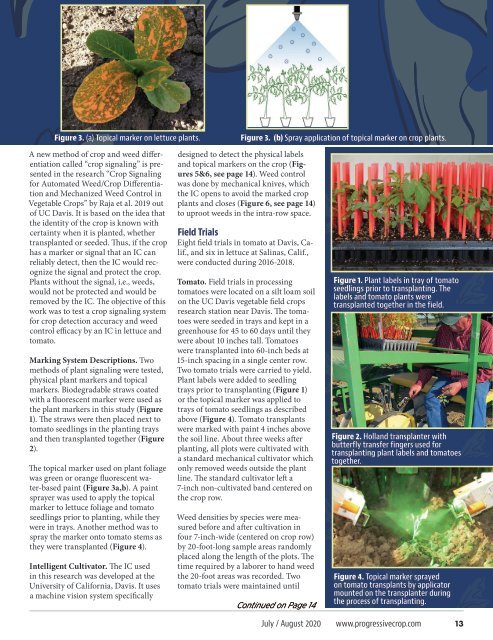You also want an ePaper? Increase the reach of your titles
YUMPU automatically turns print PDFs into web optimized ePapers that Google loves.
Figure 3. (a) Topical marker on lettuce plants.<br />
A new method of crop and weed differentiation<br />
called “crop signaling” is presented<br />
in the research “Crop Signaling<br />
for Automated Weed/Crop Differentiation<br />
and Mechanized Weed Control in<br />
Vegetable Crops” by Raja et al. 2019 out<br />
of UC Davis. It is based on the idea that<br />
the identity of the crop is known with<br />
certainty when it is planted, whether<br />
transplanted or seeded. Thus, if the crop<br />
has a marker or signal that an IC can<br />
reliably detect, then the IC would recognize<br />
the signal and protect the crop.<br />
Plants without the signal, i.e., weeds,<br />
would not be protected and would be<br />
removed by the IC. The objective of this<br />
work was to test a crop signaling system<br />
for crop detection accuracy and weed<br />
control efficacy by an IC in lettuce and<br />
tomato.<br />
Marking System Descriptions. Two<br />
methods of plant signaling were tested,<br />
physical plant markers and topical<br />
markers. Biodegradable straws coated<br />
with a fluorescent marker were used as<br />
the plant markers in this study (Figure<br />
1). The straws were then placed next to<br />
tomato seedlings in the planting trays<br />
and then transplanted together (Figure<br />
2).<br />
The topical marker used on plant foliage<br />
was green or orange fluorescent water-based<br />
paint (Figure 3a,b). A paint<br />
sprayer was used to apply the topical<br />
marker to lettuce foliage and tomato<br />
seedlings prior to planting, while they<br />
were in trays. Another method was to<br />
spray the marker onto tomato stems as<br />
they were transplanted (Figure 4).<br />
Intelligent Cultivator. The IC used<br />
in this research was developed at the<br />
University of California, Davis. It uses<br />
a machine vision system specifically<br />
Figure 3. (b) Spray application of topical marker on crop plants.<br />
designed to detect the physical labels<br />
and topical markers on the crop (Figures<br />
5&6, see page 14). Weed control<br />
was done by mechanical knives, which<br />
the IC opens to avoid the marked crop<br />
plants and closes (Figure 6, see page 14)<br />
to uproot weeds in the intra-row space.<br />
Field Trials<br />
Eight field trials in tomato at Davis, Calif.,<br />
and six in lettuce at Salinas, Calif.,<br />
were conducted during 2016-2018.<br />
Tomato. Field trials in processing<br />
tomatoes were located on a silt loam soil<br />
on the UC Davis vegetable field crops<br />
research station near Davis. The tomatoes<br />
were seeded in trays and kept in a<br />
greenhouse for 45 to 60 days until they<br />
were about 10 inches tall. Tomatoes<br />
were transplanted into 60-inch beds at<br />
15-inch spacing in a single center row.<br />
Two tomato trials were carried to yield.<br />
Plant labels were added to seedling<br />
trays prior to transplanting (Figure 1)<br />
or the topical marker was applied to<br />
trays of tomato seedlings as described<br />
above (Figure 4). Tomato transplants<br />
were marked with paint 4 inches above<br />
the soil line. About three weeks after<br />
planting, all plots were cultivated with<br />
a standard mechanical cultivator which<br />
only removed weeds outside the plant<br />
line. The standard cultivator left a<br />
7-inch non-cultivated band centered on<br />
the crop row.<br />
Weed densities by species were measured<br />
before and after cultivation in<br />
four 7-inch-wide (centered on crop row)<br />
by 20-foot-long sample areas randomly<br />
placed along the length of the plots. The<br />
time required by a laborer to hand weed<br />
the 20-foot areas was recorded. Two<br />
tomato trials were maintained until<br />
Continued on Page 14<br />
Figure 1. Plant labels in tray of tomato<br />
seedlings prior to transplanting. The<br />
labels and tomato plants were<br />
transplanted together in the field.<br />
Figure 2. Holland transplanter with<br />
butterfly transfer fingers used for<br />
transplanting plant labels and tomatoes<br />
together.<br />
Figure 4. Topical marker sprayed<br />
on tomato transplants by applicator<br />
mounted on the transplanter during<br />
the process of transplanting.<br />
<strong>July</strong> / <strong>August</strong> <strong>2020</strong> www.progressivecrop.com 13


















